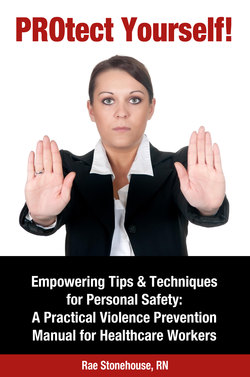Читать книгу PROtect Yourself! Empowering Tips & Techniques for Personal Safety: A Practical Violence Prevention Manual for Healthcare Workers - Rae Stonehouse - Страница 12
На сайте Литреса книга снята с продажи.
Signs & Symptoms of Aggressive Behavior
ОглавлениеDisturbed behavior can easily escalate into aggressive behavior. It is important to be aware of the early warning signals, such as restlessness, toe tapping, pacing, etc. and the expression of fear, anxiety, anger, frustration, loss, hopelessness, despair.
These emotions communicate the potential for aggressive behavior toward others, self or property.
Proactive Tip:
* Acknowledge these feelings with the person. This is the single most effective form of defusing and preventing aggression at the early stages.
Emotional Clues
We can gain valuable information from their conversation or observing their outward emotional state.
Examples of emotional clues you can expect to encounter are as follows:
Disorientation:
Comments/Questions?
“Where am I?”
“What's going on?”
“Where's my wife/husband?”
“Who are you?”
“Why am I here?”
Observable Behavior: acting restless, they look like they don't belong where they are
Fear:
Comments/Questions?
“Am I going to be all right?”
“Is everything OK?”
“I’m afraid”
Or the opposite, where they appear ready to defend themselves i.e. hyper alert asking (aggressive) demanding questions . . .
“What's going on?”
“What are you doing about...?”
“What are you doing to me?”
Frustration:
Comments/Questions?
“Why me?”
“How can this be happening to me?”
Observable Behavior: They may be short-tempered, cranky, argumentative, bothered by what may be considered trivial matters and have audible sighs.
Feelings of inadequacy:
Comments/Questions:
“It'll never work”
“Why me?”
“I am a loser”
“I'm too stupid”
“I can never do that”
“Nobody likes me”
“Nobody cares”
Rejections (real or perceived):
Comments/Questions:
“why bother, no one cares”
“nobody could ever love me”
“I tried that once and failed
“I will always fail”
“they think I am a fool”
Loss/grief: (real or perceived) (could be loss of a loved one, a friend, money, or even their reputation)
Comments/Questions:
“How could he/she do this to me?”
“What am I going to do without them?”
“I can’t go on by myself”
“There is no use in living anymore”
“Nothing matters anymore”
Anger: (could be directed outwards to others or inwards to self)
Comments/Questions:
“How dare they do that to me!”
“Who do they think they are!”
“They don’t know who they’re dealing with!”
“I’ll show them a thing or two!”
“I guess they must be right, I am useless”
“They’ll be sorry when I’m gone.”
“I might as well be dead, no one cares anyway”
Behavioural Clues
Testing limits:
Comments/Questions?
“What would you do if I punched you in the stomach?”
“What would happen if I took all my pills at one time?”
“I am leaving here and there’s not a thing that you can do about it!”
“How many aspirin does it take to kill a person?”
Intolerance of authority: (questioning authority, defying the rules)
Observable Behavior: frequent questions, attempts at dominating conversation or monopolizing authority figure’s attention, irritability, obvious “put-downs”, gossiping
Comments/Questions:
“Who died and made you God?”
“When did you go to school, if you did?”
“Who said that you’re the boss?”
“We’ll see about that!”
Need for personal space:
Observable Behavior: sometimes they have to pace indoors or maybe get outside, can’t stand to have anyone near them
Comments/Questions:
"I need some room to breathe."
“I’ve got to get out of here!”
“The walls are closing in on me”
Posture:
Observable Behavior: sitting on or moving to the edge of the chair
Speech:
-rapid, high pitched
-anxious tone
-sudden voice change
-muttering
-swearing
-sighing audibly
Motor Activity:
Observable Behavior:
-unable to sit still
-appears to be tense
-pacing
-startles easily
-increased agitation
-exaggerated movements
-moving things without purpose
-darting eyes
-staring/avoiding eye contact
-retreats when approached
-not sleeping, (when they should be)
-rocking
-banging objects
-restlessness
-destruction of physical property
-tapping of hands, fingers, feet
Others:
Observable Behavior:
-increased confusion
-eyes narrowed
-looking angry
-body tensed ( neck, jaw, arms)
-fist clenched
-withdrawal
-threatened aggression
-self-abuse
-physical aggression
-sensitivity to noise
-refusal to take medication
-flat, dull affect
-dilated pupils, (indicator of fear)
